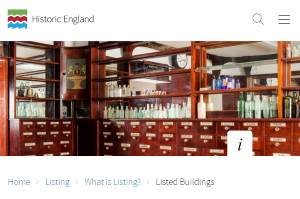 Matthew Saunders IHBC, past Director of the Ancient Monuments Society, has written to thank consultees and to say that Historic England (HE) has posted online its initial responses to his commissioned ‘Saunders Report’ on listing, which is based on an extensive consultation with the Amenity Sector.
Matthew Saunders IHBC, past Director of the Ancient Monuments Society, has written to thank consultees and to say that Historic England (HE) has posted online its initial responses to his commissioned ‘Saunders Report’ on listing, which is based on an extensive consultation with the Amenity Sector.
…really appreciative of the fastidious care with which HE supplied information…
…an openness and willingness to share facts throughout on HE’s part…
Historic England will…produce and publish a Listing Strategy…pilot small pieces of research…seek to find additional resource
Matthew Saunders writes:
… I am hugely grateful for the quality and number of the responses – some of them of very substantial length. I can assure everyone that, although the decision has been taken that the submissions will not be published, they have all been mined shamelessly by me and the leading examples have gone, complete and without any gloss or editing, straight to Debbie Mays.
None of us of course knew in 2018 how the world would be engulfed from March by shades of the Black Death. I am really appreciative of the fastidious care with which HE supplied information for the review and in particular during the period of the pandemic when there were so many other matters that demanded attention.
I have found an openness and willingness to share facts throughout on HE’s part, above all from Debbie.
The Full Report and its Appendices, at 45,000 words, is the more important document than the 3,000-word Synopsis so I do ask for your patience as that goes through the final stages. I shall write again, in the New Year, to alert you when that also is made available.
But at least you now have the Recommendations in full….
Historic England writes:
A decade after the Heritage Protection Reform Bill, in a changed and changing landscape, with public value, place-making and community engagement centre stage, it is timely for Historic England to consider afresh how best to administer the National Heritage List for England (the List).
Towards this, to establish the views of some key stakeholders, we commissioned Matthew Saunders to report on the amenity sector’s perspective of what is required.
The report ‘Towards a Strategy for the Future of the National Heritage List for England; A view from the Amenity Sector’ (the Saunders’ Report) was completed in December 2019. Below is a distillation of the report’s key findings, the synergies we have identified, a note of the further work needed or underway and our priorities for this strategic and pivotal resource.
Historic England is grateful to Matthew Saunders for the care and experienced professionalism that distinguish this report, and to the valuable contributions of those he spoke to…
Historic England commits
There is insufficient resource to deliver all the recommendations in full, but Historic England has discussed the actions proposed below and commits to a process of improving the List. We must recognise that while we want to carry on with this work, the full impact the coronavirus pandemic will have on our resources, our priorities and the nature of the tasks that we and others can undertake is yet unknown and will influence how we take the actions forward.
Historic England will:
- continue discussions with DCMS officials towards this improvement;
- use the Saunders’ Report to instigate conversations with a range of other stakeholder groups and interests to inform future direction. These conversations will take place from early 2020;
- produce and publish a Listing Strategy as soon as those conversations are complete. The Strategy will signal the direction and purpose of Listing and provide the point from which progress in its delivery may be measured. The strategy will identify actions to be progressed and the reasons why;
- continue to pilot small pieces of research to better understand the resource implications for some of the larger recommendations;
- seek to find additional resource, from a wide range of sources, to be able to progress those areas deemed most urgent;
- explore how it can work with other organisations who share an interest in developing the List;
Read more… and see the full recommendations, responses
Download the synopsis

